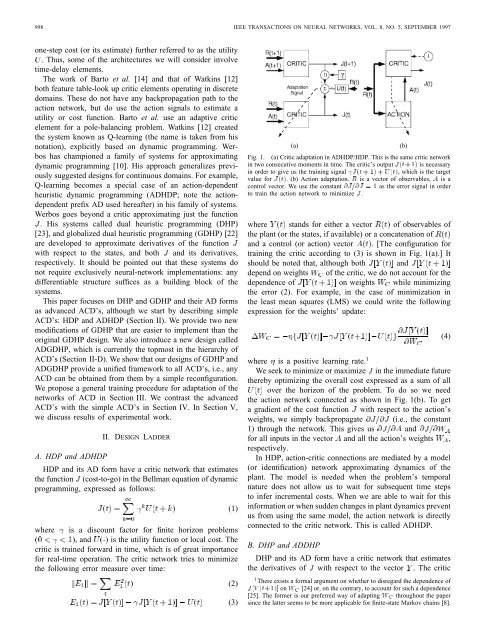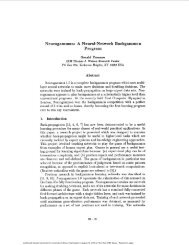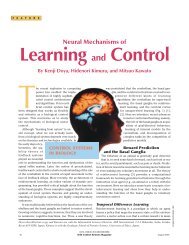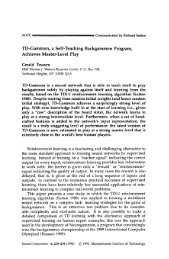Adaptive Critic Designs - Neural Networks, IEEE ... - IEEE Xplore
Adaptive Critic Designs - Neural Networks, IEEE ... - IEEE Xplore
Adaptive Critic Designs - Neural Networks, IEEE ... - IEEE Xplore
- No tags were found...
Create successful ePaper yourself
Turn your PDF publications into a flip-book with our unique Google optimized e-Paper software.
998 <strong>IEEE</strong> TRANSACTIONS ON NEURAL NETWORKS, VOL. 8, NO. 5, SEPTEMBER 1997one-step cost (or its estimate) further referred to as the utility. Thus, some of the architectures we will consider involvetime-delay elements.The work of Barto et al. [14] and that of Watkins [12]both feature table-look up critic elements operating in discretedomains. These do not have any backpropagation path to theaction network, but do use the action signals to estimate autility or cost function. Barto et al. use an adaptive criticelement for a pole-balancing problem. Watkins [12] createdthe system known as Q-learning (the name is taken from hisnotation), explicitly based on dynamic programming. Werboshas championed a family of systems for approximatingdynamic programming [10]. His approach generalizes previouslysuggested designs for continuous domains. For example,Q-learning becomes a special case of an action-dependentheuristic dynamic programming (ADHDP; note the actiondependentprefix AD used hereafter) in his family of systems.Werbos goes beyond a critic approximating just the function. His systems called dual heuristic programming (DHP)[23], and globalized dual heuristic programming (GDHP) [22]are developed to approximate derivatives of the functionwith respect to the states, and both and its derivatives,respectively. It should be pointed out that these systems donot require exclusively neural-network implementations: anydifferentiable structure suffices as a building block of thesystems.This paper focuses on DHP and GDHP and their AD formsas advanced ACD’s, although we start by describing simpleACD’s: HDP and ADHDP (Section II). We provide two newmodifications of GDHP that are easier to implement than theoriginal GDHP design. We also introduce a new design calledADGDHP, which is currently the topmost in the hierarchy ofACD’s (Section II-D). We show that our designs of GDHP andADGDHP provide a unified framework to all ACD’s, i.e., anyACD can be obtained from them by a simple reconfiguration.We propose a general training procedure for adaptation of thenetworks of ACD in Section III. We contrast the advancedACD’s with the simple ACD’s in Section IV. In Section V,we discuss results of experimental work.II. DESIGN LADDERA. HDP and ADHDPHDP and its AD form have a critic network that estimatesthe function (cost-to-go) in the Bellman equation of dynamicprogramming, expressed as follows:where is a discount factor for finite horizon problems, and is the utility function or local cost. Thecritic is trained forward in time, which is of great importancefor real-time operation. The critic network tries to minimizethe following error measure over time:(1)(2)(3)(a)(b)Fig. 1. (a) <strong>Critic</strong> adaptation in ADHDP/HDP. This is the same critic networkin two consecutive moments in time. The critic’s output J(t +1) is necessaryin order to give us the training signal J(t +1)+U(t), which is the targetvalue for J(t). (b) Action adaptation. R is a vector of observables, A is acontrol vector. We use the constant @J=@J =1as the error signal in orderto train the action network to minimize J.where stands for either a vector of observables ofthe plant (or the states, if available) or a concatenation ofand a control (or action) vector . [The configuration fortraining the critic according to (3) is shown in Fig. 1(a).] Itshould be noted that, although both anddepend on weights of the critic, we do not account for thedependence of on weights while minimizingthe error (2). For example, in the case of minimization inthe least mean squares (LMS) we could write the followingexpression for the weights’ update:where is a positive learning rate. 1We seek to minimize or maximize in the immediate futurethereby optimizing the overall cost expressed as a sum of allover the horizon of the problem. To do so we needthe action network connected as shown in Fig. 1(b). To geta gradient of the cost function with respect to the action’sweights, we simply backpropagate (i.e., the constant1) through the network. This gives us andfor all inputs in the vector and all the action’s weights ,respectively.In HDP, action-critic connections are mediated by a model(or identification) network approximating dynamics of theplant. The model is needed when the problem’s temporalnature does not allow us to wait for subsequent time stepsto infer incremental costs. When we are able to wait for thisinformation or when sudden changes in plant dynamics preventus from using the same model, the action network is directlyconnected to the critic network. This is called ADHDP.B. DHP and ADDHPDHP and its AD form have a critic network that estimatesthe derivatives of with respect to the vector . The critic1 There exists a formal argument on whether to disregard the dependence ofJ[Y (t+1)] on WC [24] or, on the contrary, to account for such a dependence[25]. The former is our preferred way of adapting WC throughout the papersince the latter seems to be more applicable for finite-state Markov chains [8].(4)









